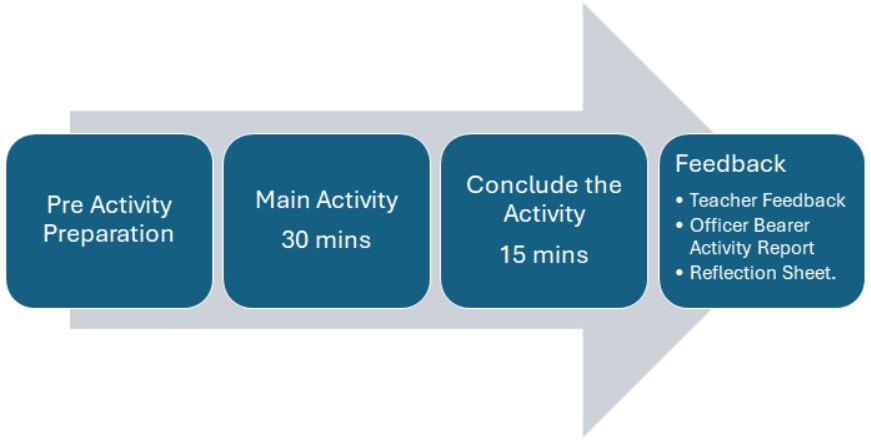

Goa Aided September Activity-Interdependence
OBJECTIVES
To identify the existence and importance of interdependence in our society.
SKILLS
Communication, Critical thinking
VALUES
Empathy, Respect
MATERIAL REQUIRED
balls of thread/rope/yarn/ribbon/jute-thread (not new, this can be re-used) as per the groups, Paper for Role Tags
PRE-ACTIVITY PREPARATION
- Teacher will decide the number of groups based on the size of class. Decide to divide the students into groups of 8-15 children.(For multiple groups, Roles can be same across groups, so guide office bearers to make multiple copies of roles as per the number of groups and students to be part of the activity.)
- Tell Office Bearers to write roles on paper of 5cmX5cm to make role tags as per number of students and groups. Role tags list refer to Annexure 1. Keep the role tags ready one day before the activity day and bring them on activity day.
- Teacher will decide the venue for the activity beforehand as per the group size. You can play in class, either by moving benches, or in front space, or in bench format. Or you can play this game in hall/ground as per space available.
- Teacher to keep yarn/thread/etc. ready for main activity day. (You can also ask few students to get thread from their home not to be purchased new.)
- Office bearers copy the questions to be discussed during the conclusion. (Ask them to prepare)
MAIN ACTIVITY
Estimated Time: 30 minutes.
1. Form Circles: Ask all students/groups to form the circles at the same time. Give groups the available ribbon/rope/yarn and ask anyone student from the group to tie one end of their ball of yarn/rope around their index finger. (At least 2-3 threads/rope per group)
(Note - Teacher takes help from the office bearers to line up the students and take them to the venue ( if activity needs to be conducted outside). Office bearers to distribute the role tags to the students.
2.Discover Connections: Students try to identify the link between their role and others. i.e. how they are connected.
- For example – Farmer is dependent on construction worker to build a new house or Farm, Construction worker is dependent on doctor to give medicines when sick, Doctor is dependent on Farmer for food, etc. so on
3. Show the Connection: As they identify the connection, they throw the yarn ball/ribbon to the role and loudly say the connection. For example – I am a doctor and I depend on farmer for food.
4. Next Connection: The newly connected role will now tie the ribbon on their finger, and then throw it to another connection.
5. To encourage more connections, limit passing the yarn balls/ribbon more than 2 times between 2 players.
6. Play until as per the time permits. Students will remain seated in same groups for discussion.
CONCLUDE THE ACTIVITY
NOTE - If time permits, teacher can give Office Bearer opportunity to do conclude this activity as mentioned below. Incase if time is short, invite the office bearer to ask the students – What did they learn from the activity?
Note: Continue doing the conclusion sitting in the groups at the same venue.
Office Bearer (with support of teacher) will conduct the conclusion of the activity. Identify those students(roles) who have not got any chance, (or less chance compared to others) to come forward.
As per the number of children, divide them into pairs (make sure the roles are different) and ask them to identify how they are dependent on each other.
If they are not able to come up with responses, other students can also help.
Ask all students– What did you learn from this activity about being dependent on each other?
Based on discussion teacher will summarize the key takeaways.
- We are dependent on each other for various needs like food, shelter, etc. This leads us to be connected to each other in our roles. This is connectedness and dependence on each other is Interdependence.
- Some connections are easy to identify, given our daily experiences and dependence, for some we have to put effort to find, as our experiences will differ. (you can refer to recap section examples)
DESH APNAYEN WALL
For this activity, the following can be updated by office bearers on the wall.
- Key learning takeaways of the activity. (encourage 5 students to write on notebook page their learnings)
- Encourage students to make list of roles we are dependent on in notebook paper. (1-2 students can make it – they can write their name below it.) (optional)
POINTS TO NOTE
- Encourage students to create as many links as possible during the activity.
- Keep the students seated in the same group for recap discussion.
ACTIVITY PHOTOS TO BE SHARED
For activity photos (2-3) to be shared to engagement officers, please share clear pictures of
- Students sitting in the circle doing the activity. – Clear view of students/group participated in activity.
- Office bearers leading the conclusion session.
- Desh Apnayen Wall photos
(One clear picture for each)
REFERENCE SECTION
Annexure 1 –
- Student
- Teacher
- Barber
- Milkman
- Farmer
- Helper didi-bhaiya/school peon
- School Principal
- PE teacher/Sports teacher
- Father
- Vegetable Vendor
- Grocery shop owner
- Class monitor
- Doctor
- Mother
- Local Govt. Official
- Garbage Cleaner






